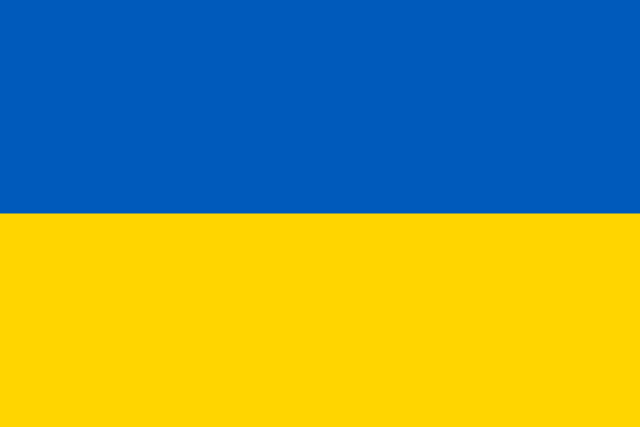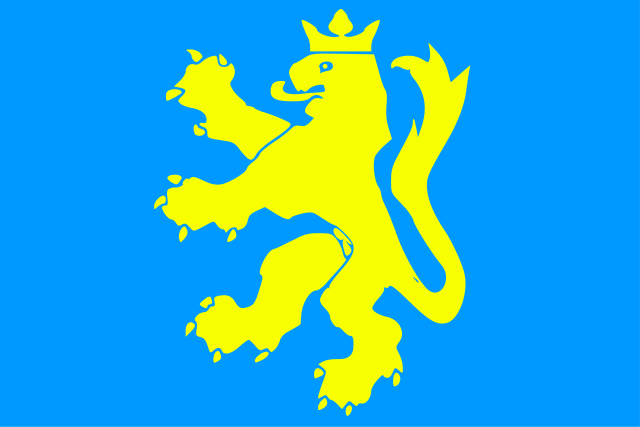The Ukraine flag is a recognizable emblem that has a particular place in the hearts of Ukrainians worldwide. The eye-catching blue and yellow pattern has a lengthy history and a profound significance that symbolizes the nation’s cultural heritage, challenges, and victories.
This article will examine the history of the Ukraine flag, including its creation, development, and symbolic meaning.
Overview of Country Ukraine
Before exploring the Ukraine flag itself, it is essential to also briefly overview the geography and demographic characteristics of the country. The Eastern European nation of Ukraine is frequently referred to as the “breadbasket of Europe.” Russia and Belarus are its neighbors to the north, east, and northeast. Poland, Slovakia, and Hungary are its neighbors to the west, and Romania and Moldova are its neighbors to the southwest. Kyiv is the nation’s capital and largest city.
Around 44 million people are living in the nation, and the majority of them are of Ukrainian ancestry. The large ethnic groups of Belarusians, Russians, and Romanians are also present. Russian is extensively spoken across the nation, particularly in its eastern parts, despite Ukrainian being the official language.
Ukraine’s history is rooted in antiquity. There is proof that people have lived there since at least 30,000 BC. Ukraine has had several invasions and occupations throughout its history, including those by the Mongols, the Ottomans, the Poles, and the Russians.
Today, the country is a democratic republic with a semi-presidential style of government. The economy of the nation is broad, with industry, metallurgy, and agriculture among its main sectors.
Eastern European Time (EET) is the local time zone for Ukraine and is 2 hours ahead of Coordinated Universal Time (UTC+2). Eastern European Summer Time (EEST), which is three hours ahead of UTC+3, is the time in Ukraine.
Ukraine has a long history of traditional music, dance, and art, and its culture is rich and diverse. Folk music from Ukraine is renowned for its eerie melodies and complex harmonies, and traditional dancing encompasses a variety of rhythms, from the quick-paced hopak to the slower kozachok.
A significant aspect of Ukrainian culture is its food, which includes favorites like holubtsi (stuffed cabbage rolls), varenyky (dumplings filled with potatoes, cheese, or meat), and borscht (a soup prepared from beets and other vegetables).
The celebration of Easter, which is regarded as the most significant event of the year, is one of the most significant customs in Ukraine. People go to church services and exchange painted eggs called pysanky during this period.

A Brief History of Ukraine
The Ukraine flag has been evolving and changing through different periods of the country’s history. Ukraine’s history is a multifaceted fabric of various cultures and civilizations that have shaped it over thousands of years. From its earliest days as a hub of Slavic civilization to its current position as an independent country, Ukraine’s history has been affected by several significant occasions and figures. Each of these events had some kind of impact on the Ukraine flag as well.
Prior History
Archaeological finds reveal that several tribes and peoples lived in the area for thousands of years before the first signs of human settlement in Ukraine appeared during the Paleolithic epoch. By the ninth century AD, the area had developed into some city-states and kingdoms, notably Kyiv, which served as the capital of the Kievan Rus, a strong confederation of Slavic tribes that ruled most of Eastern Europe.
The Mongol invasion
The Mongol invasion in the 13th century caused the Kievan Rus to fall, ushering in a time of political fragmentation and instability that lasted until the Cossacks appeared in the 16th century. These fiercely independent fighters forged a new type of Ukrainian identity based on a tradition of liberty, independence, and self-reliance that has endured as an essential aspect of the national character of Ukraine.
Polish-Lithuanian Commonwealth
The Polish-Lithuanian Commonwealth, a strong European state that benefited the region greatly, including cultural and economic success, was formed in the late 16th century, and Ukraine joined it. Periods of repression and warfare, however, occurred throughout the Commonwealth’s administration as the Ukrainian people fought for their independence and sense of self.
The Hetmanate, a strong independent state ruled by the Cossacks, rose to prominence in Ukraine in the 17th century. It experienced a brief time of independence and prosperity before being absorbed by the Russian Empire in the 18th century.
Russian Federation & Independence
Ukraine experienced a brief era of independence following World War I before joining the Soviet Union in 1922. The Soviet system altered Ukraine throughout the following seven decades, which led to the loss of much of the nation’s cultural history and identity. The demise of the Soviet Union in 1991 resulted in Ukraine regaining its independence and the start of a new era in its history.
Design & Symbolism Of Ukraine Flag
The Ukraine flag has two blue and yellow horizontal bands, with the blue band at the top and the yellow band at the bottom. The flag’s colors have great symbolic meaning since they reflect Ukraine’s natural splendor and its bountiful country.
The flag’s blue and yellow colors stand for Ukraine’s clean sky and its fertile fields of wheat and other crops, respectively. Together, these hues produce a stunning contrast that quickly evokes the terrain of Ukraine and is easily recognized.
The complicated history of the Ukrainian flag reflects the turbulent past of the nation. While the flag’s design has changed frequently over time, the colors blue and yellow have long been used as symbols of Ukrainian identity.
The Cossacks initially used blue and yellow as their national colors in the 18th century as a representation of their freedom and independence. But it wasn’t until the nineteenth century that these hues started to appear in flag designs.
During its brief period of independence in 1918, Ukraine created its first national flag. The yellow band was in two horizontal blue and yellow bands that were both the same size. This layout persisted up until 1920 when the Soviet Union’s colors were added to the flag.
Ukraine was compelled to switch from its blue and yellow flag to the red and yellow Soviet flag during the time of the Soviet Union. However, the blue and yellow flag was reinstated as the national emblem following the country’s declaration of independence in 1991, reflecting the desire of the nation to reclaim its identity and history.
The flag has undergone several revisions since then, especially in terms of size and proportion. The precise hues and sizes of the national flag were laid down in a statute on the national flag that the Ukrainian Parliament enacted in 1992. The top and bottom horizontal stripes of the present flag are blue and yellow, respectively, and they are both of equal width. The flag’s height-to-width proportion is 2:3.

History of the Ukraine Flag
The Ukraine flag is a potent representation of the nation’s history and identity. The 1848 European Revolutions, which also saw the creation of the first Ukrainian flag, were the catalyst. The design was created by Mykola Kostomarov, a renowned author and poet from Ukraine. The Kyivan Rus, a medieval state that existed before modern-day Ukraine, used a trident as its traditional emblem.
However, because of political repression and the Russian occupation, the flag was not widely used at the time. Only in 1917, during the brief period of Ukraine’s independence, did the flag’s blue and yellow hues officially change to those of the nation. The flag was flown over public areas, military bases, and government buildings.

Ukraine Flag in Space
On a mission to the Mir space station in 1995, astronaut Anatoliy Solovyov brought a small Ukraine flag along. The flag was carried by Solovyov, a Ukrainian, as a reminder of his nation’s accomplishments in space exploration and to strengthen Ukrainian pride.
Before being delivered to Ukraine, the flag spent nearly six months in orbit above the Earth. The flag was exhibited in Kyiv’s National Museum of History after its return as a representation of Ukraine’s space accomplishments.
Ongoing Ukraine-Russia War
The present conflict between Ukraine and Russia started in 2014 after Crimea, a peninsula that had previously been part of Ukraine, was taken by Russian soldiers. Since then, the conflict in Ukraine’s east has intensified into a full-fledged war, which has resulted in thousands of fatalities and millions of displaced people.
The Ukraine flag is still flown everywhere around the globe as a representation of Ukraine’s fight for independence and sovereignty despite the ongoing hostilities. To demonstrate their support for the nation and its citizens, Ukrainian communities and supporters from throughout the world have flown the flag at different public gatherings, activities, and protests.
Today, especially after the conflict with Russia, people have become more familiar with the Ukrainian flag as a symbol of the nation’s struggle for autonomy and independence. The flag has evolved into a representation of resistance to Russian aggression and meddling in the internal affairs of other nations. For instance, Ukraine flags were frequently present with other national flags during rallies against Russian meddling in the 2016 US presidential election.
Bottom Line
The Ukraine flag is much more than simply a depiction of the country. It also symbolizes the rich cultural history, independence fights, and steadfast spirit of the people. We have looked into the profound meanings and importance underlying every element of the Ukraine flag, from its creation and history to its colors and design.
As we have seen, the Ukraine flag is more than simply a piece of fabric; it is a symbol of the nation’s spirit, goals, and victories.